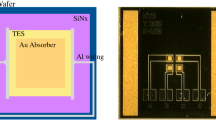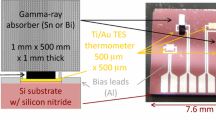Abstract
We are developing metallic magnetic calorimeters for high-resolution gamma-ray spectroscopy for non-destructive assay of nuclear materials. Absorbers for these higher-energy photons can require substantial thickness to achieve adequate stopping power. We developed a new absorber fabrication process using dry-film photoresists to electroform cantilevered, thick absorbers. Gamma detectors with these absorbers have an energy resolution of 38 eV FWHM at 60 keV. In this report, we summarize modifications to STARCryo’s “Delta 1000” process for our devices and describe the new absorber fabrication process.
Similar content being viewed by others
Avoid common mistakes on your manuscript.
1 Introduction
High-resolution gamma-ray spectroscopy using metallic magnetic calorimeters (MMCs) has already demonstrated improved accuracy over high-purity germanium (HPGe) detectors for a non-destructive assay (NDA) of nuclear materials [1].
MMCs are low-temperature particle detectors with an absorber that is thermally coupled to a paramagnetic sensor in a weak magnetizing field. The paramagnetic sensor is magnetically coupled to a SQUID, and the energy of an absorbed particle is determined by measuring the temperature-induced magnetization change [2]. For the gamma rays, the absorbers need to be up to a few hundred microns thick to have enough stopping power [3, 4].
Our group has been developing gamma-ray MMCs that integrate the SQUIDs and sensing coils to increase flux coupling and signal-to-noise ratio [5, 6]. Fabrication of the absorbers for such MMCs is challenging because SQUIDs are sensitive to chemical attack and elevated processing temperatures. We have recently reported a complete fabrication process to electroform cantilevered Au absorbers by using AZ125nXT photoresist to define the tops and a sacrificial, sputtered Cu blanket layer to define the posts [5]. Although this process was successfully applied on several test structures, on the real MMC chip we found that film stress of the sputtered Cu damaged underlying structures. We found that the Cu film stress problem could be eliminated if the film was evaporated rather than sputtered. However, an easier fabrication process was highly desirable to reduce the time and frequent rework required for the Cu/AZ125nXT process.
In this report, we introduce a new thick absorber fabrication process by using two layers of dry-film photoresist to define both posts and tops. The new process is completely compatible with the STARCryo Delta 1000 SQUID microfabrication process, enabling future commercial deployment of our integrated SQUID/sensor detector designs. Using the dry-film approach, we have completed fabrication of 14-pixel arrays of integrated SQUID/sensor MMCs with attached absorbers.
2 Fabrication
The MMCs used in this paper were designed by UNM and fabricated in collaboration with STARCryo. Description of all layers is given in Table 1. Steps 1–8 are performed on the full 4” wafer and are a modified version of the commercial STARCryo Delta 1000 SQUID process. These steps define the trilayer [7] and two Nb wiring layers from which the SQUIDs, sensing coils, input circuits and magnetizing circuits are made. The wafer is then diced into cm-scale MMC chips, and layers 9–13, the Ag:Er paramagnetic sensor, gold thermalization layer, Nb superconducting cap and cantilevered gold absorbers are added.
2.1 Modifications to “Delta 1000” Process for MMC
The Delta 1000 process was modified to increase the thickness of all wiring layers up to about 500 nm. A second modification to the Delta 1000 process was to reduce the thickness of the SiO2 insulation layers, primarily to increase magnetic coupling of the MMC sensing coils to the paramagnet, but measurements with test structures indicated that this also improved the current-carrying capacity of the vias. For our current MMC wafer, the target oxide layer thickness was 100 nm. Although similar thicknesses worked well on test structures, we found random electrical shorts on the wafer. We have recently found that a subtle problem with the PECVD SiO2 tool may have been responsible for these shorts. That problem has been fixed and we plan to test the thin oxide again. The third change to the Delta 1000 process was to add a step to deposit Nb:Ta alloy passive persistent-current switches [6, 8] onto trilayer wiring.
2.2 cm-Scale Chip Level Fabrication
The first step of the cm-scale chip level process is the deposition of the paramagnetic sensor material. To address the parasitic heat capacity problem in Au:Er sensors due to quadrupole splitting of Au nuclei in the presence of Er ions [9], we are exploring the use of Ag as a host material. 1000 ppm Ag:Er paramagnet was synthesized in a home-made vacuum/controlled atmosphere induction furnace and sputter deposited on to the chip in a dedicated sputtering system [10].
Then, Au thermalization layer is electroplated over the paramagnetic sensor and it is followed by PECVD SiO2 blanket insulation layer to isolate the paramagnet from the following superconducting Nb layer. Next the Nb superconducting cap layer is sputter deposited to increase the magnetic field concentration in the paramagnet [11]. There are circular openings patterned in the superconducting cap to provide access to the paramagnet underneath. As a last step, the cantilevered Au absorbers are electroplated.
2.3 Novel Cantilevered Absorber Fabrication Process
Two layers of MX5000 series dry-film photoresists from DuPont are used to define the molds for cantilevered absorbers. To define posts, 20-µm-thick MX5020 is used, and 50-µm-thick MX5050 is used for the tops. Processing both photoresist layers is very similar. The basic process includes lamination, exposure and development. Prior to laminating the first film, the cm-scale chip is cleaned by rinsing with acetone and IPA and then descummed for 5 min under O2 plasma. To laminate the film, the protective polyethylene layer is removed from one side. The film is rolled onto the chip on a hot plate at 90–100 °C, with gentle pressure applied by a homemade hand roller. Then, the photoresist is exposed with 365-nm UV light with the intensity of 18 mW/cm2 for 2 s. Although 20 mW/cm2 or higher intensities are recommended for high resolution, 18 mW/cm2 was the maximum intensity available to us. The photoresist is developed in 0.75 wt% K2CO3 solution at 30 °C for 1 min (3 min for MX5050). Then, the chip is rinsed in DI water and dried with a N2 gun. After each of the lamination, exposure and development steps, the chip is baked on a 90–100 °C hot plate for 45 s. These are applied to enhance adhesion, resolution and resistance to chemicals, respectively.
After the posts are defined over the circular holes in the Nb cap layer, the SiO2 layer that would otherwise prevent direct contact of the posts to the paramagnet thermalization layer is removed using a dry etch. Then, sample is ashed for 5 min with O2 plasma and 250-nm Au seed layer is sputter deposited. Following the seed layer, the 50-µm-thick photoresist film is rolled on and processed to define the absorber tops. A diagram of two-layer mold is shown in Fig. 1 (left).
Left, schematic cross section of MMC coil area with two-layer dry-film photoresist mold ready for plating. Nb cap and oxide layer are opened for the electroformed gold to make direct contact to the paramagnet’s gold thermalization layer. Right, diagram of the same area after the absorber is electroformed and mold is removed (Color figure online)
Electroplating is done in a 1-L beaker with 250 ml fresh Technic D7990 RTU solution with Au density of 8.2 g/L. Vigorous agitation is sustained by using a water pump directed toward the chip. 0.25 A/dm2 rectangular pulses are applied during plating. After plating both photoresist layers are removed in DMSO with ultrasound at 50–60 °C, typically for 30 min. A diagram of the cantilevered absorber after the mold removed is shown in Fig. 1 (right).
SEM images of a completed MMC array are shown in Fig. 2 (left), and on the right, we see a single 475 × 475 × 30 µm3 absorber on eight 50-µm-diameter posts. The thickness of the absorbers is uniform across the cm-scale chip. They are robust, surviving multiple rapid immersions into liquid nitrogen and long sonications in solvents. The residual resistivity ratio (RRR) of meander shape samples which were designed to obtain measurable resistance and were electroplated in the same setup as absorbers was measured to be ~7. This is significantly smaller than what we have previously reported with samples made by using Techni Gold 25ES solution [5]. Other plating parameters, such as plating temperature and agitation, may have influence on this as well [12]. Further investigation is on the way to improve the RRR.
In addition to the 30-µm-thick absorbers on the MMC array chip shown in Fig. 2, we have successfully produced 100-µm-thick absorbers on test structures by layering two 50-µm-thick dry-film photoresists and exposing them together. Resolution of the molds was slightly degraded, and this can be improved by increasing the intensity of the exposure. Additionally, the top surface finish of electroformed 100-µm absorbers is not as smooth as 30-µm absorbers. RRR measurements on a rough-surface 100-µm-thick meander shape sample show no change compared to a smooth-surface 5-µm-thick meander shape sample, indicating that the rough-surface finish does not imply degradation of RRR, which agrees with the experience of the Heidelberg group [13].
The completed devices shown in Fig. 2 were characterized at 10 mK in a cryostat with dilution refrigerator at LLNL [6]. Signal rise times of 7 µs indicate good thermal coupling between the Au absorber and the Ag:Er sensor. Gamma detectors with these absorbers have an energy resolution of 38 eV FWHM at 60 keV and a Gaussian response function. These properties make our gamma-ray MMCs well suited for high-accuracy non-destructive assay of radioactive materials and other applications in nuclear safeguards.
References
C. Bates et al., J. Low Temp. Phys. 184, 351–355 (2016). https://doi.org/10.1007/s10909-015-1348-0
A. Fleischmann, C. Enss, G.M. Seidel, Metallic magnetic calorimeters, in Cryogenic Particle Detection, ed. by C. Enss (Springer, Berlin, 2005), pp. 151–216. https://doi.org/10.1007/10933596_4
C.R. Bates et al., J. Low Temp. Phys. 176, 631–636 (2014). https://doi.org/10.1007/s10909-013-1063-7
C. Pies, A. Pabinger, S. Kempf, A. Fleischmann, L. Gastaldo, C. Enss, AIP Conf. Proc. 1185, 603 (2009). https://doi.org/10.1063/1.3292414
L.N. Le, R. Hummatov, J.A. Hall, R.C. Cantor, S.T.P. Boyd, J. Low Temp. Phys. 184, 108–113 (2016). https://doi.org/10.1007/s10909-016-1478-z
S. T. P. Boyd, R. Hummatov, G. B. Kim, J. A. Hall, R. Cantor, S. Friedrich, J Low Temp Phys [this Special Issue LTD17 (2018)]
R. Cantor, J. Hall, IEEE Trans. Appl. Supercond. 15, 82–85 (2005). https://doi.org/10.1109/TASC.2005.849699
R. Hummatov, L.N. Le, J.A. Hall, S. Friedrich, R.A. Cantor, S.T.P. Boyd, IEEE Trans. Appl. Supercond. 27(4), 2200205 (2017). https://doi.org/10.1109/TASC.2016.2626918
C. Enss, A. Fleischmann, T. Gorlach, Y.H. Kim, G.M. Seidel, H.F. Braun, AIP Conf. Proc. 605, 71 (2002). https://doi.org/10.1063/1.1457598
F. Jaeckel, V. Kotsubo, J.A. Hall, R. Cantor, S.T.P. Boyd, J. Low Temp. Phys. 167, 286–291 (2012). https://doi.org/10.1007/s10909-012-0564-0
S.T.P. Boyd, R.H. Cantor, AIP Conf. Proc. 1185, 595–598 (2009). https://doi.org/10.1063/1.3292412
Private communication with Therese Souza from Technic, Inc
Private communication with Dr. Sebastian Kempf
Acknowledgements
This work was funded by the U.S. Department of Energy Office of Non-proliferation R&D (NA-22) under grant LL16-MagMicro-PD2La. It was performed under the auspices of the U.S. DOE by Lawrence Livermore National Laboratory under Contract DE-AC52-07NA27344.
Author information
Authors and Affiliations
Corresponding author
Rights and permissions
About this article
Cite this article
Hummatov, R., Hall, J.A., Kim, GB. et al. Fabrication of High-Resolution Gamma-Ray Metallic Magnetic Calorimeters with Ag:Er Sensor and Thick Electroplated Absorbers. J Low Temp Phys 193, 752–757 (2018). https://doi.org/10.1007/s10909-018-1946-8
Received:
Accepted:
Published:
Issue Date:
DOI: https://doi.org/10.1007/s10909-018-1946-8






